
Christianity in Belarus owes its birth to the Ecumenical Patriarch Photius I (St Photios the Great). According to tradition, the Kievan Rus were converted under him around 867AD and it was the Ecumenical Patriarch who provided their first bishop. A century later, the Baptism of Kiev firmly allied the Rus with the Byzantine Empire. According to the Primary Chronicle, at Constantinople, the advisors of Prince Vladimir the Great of Kiev were so astounded by the beauty of the cathedral of Hagia Sophia (Church of the Holy Wisdom) and the liturgical service held there that they made up their minds there and then about the faith they would like to follow. Accordingly, Prince Vladimir travelled to Constantinople where he was received into the Orthodox Church by baptism and married the sister of the Byzantine Emperor.

The legacy of the Ecumenical Patriarchate in Belarus was a lengthy one. Until 1686, the Metropolitanate of Kiev and all Rus was a constituent part of the Ecumenical Patriarchate. In 1684, the Patriarch of Moscow sent a delegation to Constantinople formally requesting the right to appoint the Metropolitan of Kiev, but this request was refused by the Ecumenical Patriarch. The following year, Moscow acted uncanonically and in disregard of the Ecumenical Patriarch by appointing its own candidate, and in 1686 the Ecumenical Patriarch Dionysios IV was persuaded to issue a Tomos regularizing this act, having accepted a large sum of money from Moscow to do so.
The Ecumenical Patriarchate has on many occasions since then protested at this event and referred to it as uncanonical and illegal, but has stopped short of revoking the Tomos of 1686. Many have seen in these protests a tacit support for the re-establishment of the indigenous churches of the Rus under Constantinople.
“In 1924, Ecumenical Patriarch Gregory VII in the Tomos for the granting of autocephaly of the Polish Orthodox Church, wrote: “The first part of Our Throne of the Kyiv Metropolis, and Orthodox Metropolitan of Lithuania and Poland, dependent, as well as their attachment to the Holy Church of Moscow is done not by the provisions of the canonical Rules and also everything has not been complied with that has been established with respect to the full autonomy of the church and the Metropolitan of Kiev, who held the title of Exarch of the Ecumenical Throne“. Patriarch Gregory cited three grounds, which allowed him to grant autocephaly to the Orthodox Church within the revived Polish state. This is, firstly, the need to harmonize religious borders with the new political boundaries, and secondly, the right of the Ecumenical Patriarchal Throne to support the Orthodox Churches, “who are in need” and, thirdly, infringement of the canonical rules, committed in 1686 (Orthodox dioceses in Poland, Lithuania and Belarus in 1686 were part of the Kyiv Metropolis).”
“In March 2005, Archbishop Vsevolod Skoplskim…who is a curator “of Ukrainian politics” at the Ecumenical Patriarchate at a meeting with President Yushchenko said that the Patriarchate of Constantinople never recognized the legality of transition of the Metropolis of Kiev of Constantinople to the Moscow Patriarchate and, therefore, to this day it continues to consider Ukraine as its canonical territory. While this statement has caused severe protests from the Russian Orthodox Church, officials of Constantinople did not comment on the statement of Archbishop Vsevolod, implying that they effectively ignore the resentment of Moscow.”
“Most recently, in Kiev during the anniversary celebrations on the 1020th anniversary of the Baptism of Kievan Rus, the Ecumenical Patriarch Bartholomew of Constantinople has repeatedly stated that Church of Constantinople is the Mother Church in relation to the Ukrainian Orthodox Church, not Moscow. On July 26 2008 in his keynote address to the Ukrainian people, uttered at the Sofia Square in Kiev, Patriarch Bartholomew expressly called the Metropolis of Kiev’s accession to the Moscow Patriarchate “annexation”.
Volodymyr Bureha: Accession of the Kyiv Metropolis to the Moscow Patriarchate: How it was (2008)
After the partition of Poland and the annexation of Belarus by Russia in 1795 the religious affiliation of Belarus became divided between the Russian Orthodox Church and the Roman Catholic Church, with a small minority of Greek Orthodox and Protestants. When the November Uprising of 1830-31 against Russian rule failed, the Roman Catholic Church was suppressed in favour of the Russian Orthodox Church. Since that time, the story of Christianity in Belarus is united with its political oppression firstly by the Russian Empire, then by the Soviet Union, and today by the successors of the USSR. All have promoted the Russian Orthodox Church and suppressed the indigenous church of Belarus.
In 1922, the Byelorussian Autocephalous Metropolia was founded at a Sobor in Minsk by former members of the Polish Orthodox Church, which would be granted autocephaly by the Ecumenical Patriarch in 1924, but this church had effectively been suppressed in Stalin’s “Great Purge” by 1938. During Nazi occupation, a new Sobor in Minsk in 1942, formed by clergy willing to collaborate with the Nazi regime, declared an autonomous Byelorussian Autocephalous Orthodox Church. The defeat of Nazism meant that this church was absorbed into the Russian Orthodox Church outside Russia in 1946. In 1949, Bishop Siarhiej Okhotenko of the uncanonical Ukrainian Autocephalous Orthodox Church in Exile attempted independently to revive the BAOC and several descendants of this revival exist today.
Since 1946, the Russian Orthodox Church has exerted dominance over Belarus and has even established its own “Belarusian Orthodox Church”. Conflict between the large, wealthy and politically well-connected Moscow Patriarchate and those small, impecunious, marginalized groups in exile that have been struggling for the true and autonomous Belarusian Church has regrettably become entrenched.
For the purposes of clarification, the Byelorussian Patriarchate of St Andrew the First-Called Apostle takes the view that the Russian Orthodox Church in Belarus is effectively a colonizing power, and that it can never take the place of the authentic Belarusian Orthodox Church. Nor does it recognize uncanonical attempts by exiled bishops of Ukrainian churches to revive the former Byelorussian Autocephalous Orthodox Church.
A Patriarch for Belarus – His Beatitude Peter Andreas Zhurawetsky (1901-94)

The future Patriarch Peter Andreas Zhurawetsky was born in Uhniv, Galicia, in what was then Austria but is now Ukraine, on 7 December 1901. Amid the upheaval of war and revolution, he came to the Faculty of Evangelical Theology at the University of Vienna to study. Among his classmates were the future Archbishop Andrei Kuschak, Bishop Bohdan Shpylka and Ukrainian Kievan Patriarch Mstyslav I Skrypnyk. He then commenced missionary work among Ukrainian exiles in the United States in 1925, and also had posts as secretary to Bishop Joseph Zuk and his successor Bishop Theodor Shpilka of the Ukrainian Orthodox Church in America.
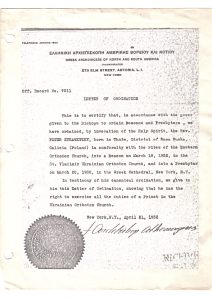
In 1927, Metropolitan Platon Rozdhestvensky and the Holy Synod of the Russian Orthodox Church in North America, working in opposition to the uncanonical “Russian Orthodox Church outside Russia” (ROCOR), authorized the “formation of a group of Eastern Orthodox bishops in North America” under Aftimios Ofiesh (1880-1966), Bishop of Brooklyn in the Russian Orthodox Church. In this situation, Eastern Orthodox bishops in America were often asked to co-operate across their ethnic boundaries. Zhurawetsky was part of the Ukrainian Orthodox Church under Archbishop Palladios Rudenko, but that Archbishop’s illness meant that on 20 March 1932, at Holy Trinity Greek Orthodox Cathedral in New York City, Zhurawetsky was instead ordained priest by Archbishop Athenagoras Spyrou of the Greek Orthodox Archdiocese of North and South America (who would become the Ecumenical Patriarch in 1948). In 1933, Archbishop Ofiesh married in contravention of the canons and the recognition of his group by the Russian Orthodox Church came to an end, although most of its clergy continued their work in other jurisdictions.


In 1940, Father Zhurawetsky was transferred to the Greek Orthodox Archdiocese of North and South America under Metropolitan Christopher Contogeorge. In 1942 Metropolitan Christopher raised Father Zhurawetsky to Mitred Archpriest and made him Administrator of the Eastern Catholic and Apostolic Diocese of America. A legal dispute between Metropolitan Christopher and the Greek Orthodox Archdiocese was concluded with the issuance of a letter from Archbishop Athenagoras on behalf of the Ecumenical Patriarch of 1 March 1945, which confirmed the canonical character and validity of the ecclesiastical acts of Metropolitan Christopher.
Formation of the Standing Episcopal Conference and consecration of Father Zhurawetsky

In 1922, the regime of Lenin confiscated all property from the Russian Orthodox Church and gave its support to the Temporary Higher Church Administration formed by a number of priests. This body became known as the Renovated or Living Church, and it acted to depose Patriarch Tikhon of Moscow and re-establish the Holy Synod originally proclaimed by Peter the Great to rule the Church in 1721. Although the Living Church was seen as a pro-Soviet organization, receiving official standing and support from the government and Communist intellectuals, its greatest support from within the Church came from married priests who were excluded from the episcopate by the canons.
Although it gained only limited popular support, the Living Church had established a presence in America where its policy of allowing bishops to marry had attracted a number of clergy. The Detroit Sobor of 1924 resulted in a temporary administration for the American congregations until such time as the Russian Orthodox Church had re-established its central church authority. The Living Church proceeded to establish a fierce and at times bloody rivalry with the clergy of the Moscow Patriarchate and the Russian Orthodox Church outside Russia (ROCOR), with both groups denouncing each other as uncanonical and schismatic.
However, the Living Church was fatally undermined when in 1927 Metropolitan Sergius of Nizhny Novgorod concluded his “alliance with Satan” by pledging the loyalty of the Russian Orthodox Church to the atheist Soviet Union. After this point, ROCOR became steadily more accommodating of Stalin’s regime while the Living Church was more isolated.
In 1943, Stalin disbanded the Living Church altogether and permitted the election of a new Russian Orthodox Patriarch. Most of the Living Church clergy in America joined ROCOR at this point, but a minority, including its married bishops, elected to continue under Metropolitan Nicholas Kedroff (1902-44), formerly Archbishop of North America and the Aleutian Islands in the Living Church. But his death the following year left his clergy stranded. When the Sobor of the Russian Orthodox Church in Moscow convened to elect a Patriarch in 1945 these American clergy intended to be present and relations with them were among the subjects discussed.
Unfortunately, and perhaps unsurprisingly given the exigencies of the closing months of World War II, the American clergy were delayed in their travel itinerary and the Sobor reached its decisions in their absence, with the Patriarch of Moscow issuing an Ukase in February 1945. The Ukase determined that it would only recognize the Russian Orthodox Church in America if the latter would abstain “from political activities against the USSR” and effectively cede control of its affairs to Moscow. This demand reflected the fact that the Moscow Patriarchate was now hand-in-glove with the regime of Joseph Stalin, who would doubtless have relished the prospect of turning the American church into a KGB base on American soil. The Russian Orthodox Church in America considered the matter at the Cleveland Sobor of 1946 and responded by rejecting any further administrative control of their affairs by Moscow, while continuing the stance of explicitly not breaking communion that had also become the historical policy of the Russian Orthodox Church outside Russia. Rather than submit to Moscow, they would instead seek paternal affiliation with the Ecumenical Patriarchate on the basis of the recognition of the autonomy that they had exercised since the Detroit Sobor of 1924.
It is from this recognition that the Church in Russia and indeed in Belarus had become irretrievably politicized through its accommodation of Communism that the ideology of opposition to it during the succeeding decades stems. In a letter of January 1970, Zhurawetsky wrote, “One hundred years ago the Almighty restored his true (Old) Catholic Church and has raised up modern prophets and Apostles to direct the work. Under the guidance of heaven, powers of priesthood have been brought back to earth by the ministry of angels. They did not come from any political unit.”
In 1950, the Standing Episcopal Conference of Orthodox Bishops was organized in the United States and canonically structured the following year. It was recognized by the Ecumenical Patriarch by letter of 4 April 1951.
Below right: Letter of Archbishop Damaskinos of the Greek Diocese of the Western and Southern States of America to Bishop Peter Zhurawetsky concerning the formation of the Standing Episcopal Conference, 6 November 1950.


 The Standing Episcopal Conference was the first ecumenical body of Eastern Orthodox hierarchs in America and continues to exist today. It predates the Standing Conference of the Canonical Orthodox Bishops in America, formed in 1960, and the present Assembly of Canonical Orthodox Bishops of North and Central America, formed in 2010. Unlike those latter organizations, which have a purely consultative role, the Standing Episcopal Conference was a canonical synod with plenary jurisdiction. Through this act, the bishops expressed once more their non-acceptance of the stance of ROCOR which opposed all ecumenism with fellow Orthodox, even in the diaspora situation.
The Standing Episcopal Conference was the first ecumenical body of Eastern Orthodox hierarchs in America and continues to exist today. It predates the Standing Conference of the Canonical Orthodox Bishops in America, formed in 1960, and the present Assembly of Canonical Orthodox Bishops of North and Central America, formed in 2010. Unlike those latter organizations, which have a purely consultative role, the Standing Episcopal Conference was a canonical synod with plenary jurisdiction. Through this act, the bishops expressed once more their non-acceptance of the stance of ROCOR which opposed all ecumenism with fellow Orthodox, even in the diaspora situation.
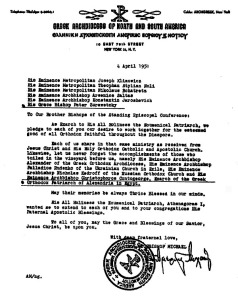
The first Moderator of the Standing Episcopal Conference was Metropolitan Joseph Klimovich, of the Russian Orthodox Church in America. Other member hierarchs were Metropolitan Fan S. Noli of the Albanian Orthodox Church, Archbishop Arsenios Saltas, Exarch in the United States of the Greek Orthodox Patriarchate of Alexandria, Metropolitan Nicholas Bohatyretz of the Ukrainian Orthodox Church of Canada, Archbishop Konstantin Jaroshevich of the Alexandrian Patriarchate and – admitted by ekonomia – Archbishop Josef Zielonka of the Polish Old Catholic Church of America and Europe. The new bishop Zhurawetsky was also a member; he had been consecrated to the Sacred Episcopate at Ss. Peter and Paul Orthodox Church, Springfield, Mass., on 15 October 1950, by Metropolitan Joseph Klimovich assisted by Archbishops Jaroshevich, Bohatyretz, Zielonka and Peter M. Williamovicz (of the Polish Old Catholic Church).

On 15 January 1951 the Standing Episcopal Conference incorporated the Holy Orthodox Catholic Patriarchate of America with Metropolitan Joseph Klimovich (1880-1961) and Bishop Peter Zhurawetsky as officers. Metropolitan Klimovich was elected the first Patriarch on 14 October 1950. He retired in 1957 and was succeeded by Bishop Peter as the second Patriarch. As Patriarch, Bishop Peter took the title Peter II. Bishop Peter had previously been raised to the archiepiscopacy on 14 March 1955 by Archbishop Jaroshevich and Bishop Miroslav Simonis of the Holy Orthodox Church of Christ.
Archbishop Jaroshevich was a Belarusian by birth. He had come to the United States in search of a better life in 1910 and, after being converted by a street preacher in New York, spent four years studying at Johnson Bible College. He eventually returned to his homeland in 1921 and established a network of parishes. This work survived for some years, but official pressure under the Soviet Union forced most of the parishes into the Russian Orthodox Church after 1938.

 Metropolitan Zielonka’s jurisdiction, the Polish Old Catholic Church, had formed in 1937 from a number of American parishes that wished to remain independent of the Polish National Catholic Church. Ultimately, they were united by their adherence to Western Orthodoxy and the Catholic faith, but did not accept the First Vatican Council of 1870 and so remained separate from Papal jurisdiction. Included in their number were not only Poles but also expatriate Lithuanians and Belarusians. The church concentrated mostly on pastoral outreach and by 1961 there were 22 affiliated parishes with most being located in New Jersey and some in Pennsylvania and Massachusetts.
Metropolitan Zielonka’s jurisdiction, the Polish Old Catholic Church, had formed in 1937 from a number of American parishes that wished to remain independent of the Polish National Catholic Church. Ultimately, they were united by their adherence to Western Orthodoxy and the Catholic faith, but did not accept the First Vatican Council of 1870 and so remained separate from Papal jurisdiction. Included in their number were not only Poles but also expatriate Lithuanians and Belarusians. The church concentrated mostly on pastoral outreach and by 1961 there were 22 affiliated parishes with most being located in New Jersey and some in Pennsylvania and Massachusetts.


On 17 December 1960, Metropolitan Zielonka passed to his eternal reward. He had previously named Bishop Zhurawetsky as his successor in a document of the previous year. Significantly, the original ethnic aspect of his mission had now become absorbed into a much wider Old Catholic mission “of both America and Europe”.
The Holy Orthodox Catholic Patriarchate of America under Patriarch Zhurawetsky
During the reign of Patriarch Peter II, the Holy Orthodox Catholic Patriarchate of America continued to be paternally affiliated with the Ecumenical Patriarchate through His All Holiness Patriarch Athenagoras I. Patriarch Peter II had changed the name of his jurisdiction inherited fro m Metropolitan Zielonka to Christ Catholic Church of the Americas and Europe in order to reflect its wider mission in December 1960. He was additionally elevated by the Holy Synod of Christ Catholic Church on 1 July 1962 to be Catholicos of the Old Catholic Church. He also served as President of the Holy Synod of the Orthodox Catholic Churches of America. Of the Holy Orthodox Catholic Patriarchate of America he would write many years later, “The aim of this Holy American Patriarchate of Eastern and Western tradition is to be a spring-board upon which all the independent groups of Catholics can unite to form a viable church with beliefs and principles of undivided Orthodoxy.”
m Metropolitan Zielonka to Christ Catholic Church of the Americas and Europe in order to reflect its wider mission in December 1960. He was additionally elevated by the Holy Synod of Christ Catholic Church on 1 July 1962 to be Catholicos of the Old Catholic Church. He also served as President of the Holy Synod of the Orthodox Catholic Churches of America. Of the Holy Orthodox Catholic Patriarchate of America he would write many years later, “The aim of this Holy American Patriarchate of Eastern and Western tradition is to be a spring-board upon which all the independent groups of Catholics can unite to form a viable church with beliefs and principles of undivided Orthodoxy.”
 As Patriarch, Peter II was less concerned with establishing a network of parishes than with building what he believed to be his mission of creating a genuine American Orthodox Patriarchate out of the divided splinters that had resulted from many attempts to plant Orthodoxy there. This emphasis earned him heavy criticism from some of his more democratically-inclined clergy who believed in growing a church from the bottom up, but this did not deter Patriarch Peter. His belief was in benevolent autocracy as a traditional form of governance, and that it was of the first importance that those clergy looking for a hierarch under whom they could unify should be able to find one. Aware that his jurisdiction was one of few such bodies that represented canonical Orthodoxy, Patriarch Peter was sought out by many clergy over the years who came to form a large and sometimes unruly family under his paternal oversight. Today, there are many Orthodox churches both in the United States and beyond that can trace their origins to him.
As Patriarch, Peter II was less concerned with establishing a network of parishes than with building what he believed to be his mission of creating a genuine American Orthodox Patriarchate out of the divided splinters that had resulted from many attempts to plant Orthodoxy there. This emphasis earned him heavy criticism from some of his more democratically-inclined clergy who believed in growing a church from the bottom up, but this did not deter Patriarch Peter. His belief was in benevolent autocracy as a traditional form of governance, and that it was of the first importance that those clergy looking for a hierarch under whom they could unify should be able to find one. Aware that his jurisdiction was one of few such bodies that represented canonical Orthodoxy, Patriarch Peter was sought out by many clergy over the years who came to form a large and sometimes unruly family under his paternal oversight. Today, there are many Orthodox churches both in the United States and beyond that can trace their origins to him.  However, Patriarch Peter was wholly unconcerned with numbers of followers and accepted that his mission would always be to a widely dispersed congregation of diverse ministries. One important aspect of the administration of his Patriarchate was that he abolished the usual Eastern Orthodox practice of celibacy for bishops, holding this to be not a dogma of the Church but purely a matter of discipline that could be changed without compromise to the faith. His wife Emily died in July 1984.
However, Patriarch Peter was wholly unconcerned with numbers of followers and accepted that his mission would always be to a widely dispersed congregation of diverse ministries. One important aspect of the administration of his Patriarchate was that he abolished the usual Eastern Orthodox practice of celibacy for bishops, holding this to be not a dogma of the Church but purely a matter of discipline that could be changed without compromise to the faith. His wife Emily died in July 1984.
The canonicity of the acts of Patriarch Peter are unquestionable. As further evidence of this, two letters of recognition are of particular importance. The first was written by the Pope and Patriarch of Alexandria, Nicolaos VI, in 1978. In it, he states “This Apostolic and Patriarchal Church of St Mark, following its long Tradition to receive similar appeals from Orthodox Churches and respond to them affectionately and motherly, recognizes you as a Canonical Bishop.” The second was written by Metropolitan Ireney of the Orthodox Church of America in 1976 (Click the images below to enlarge the letters).
Byelorussian Orthodox Catholic Church (Belaruskaia Subozhnia) – an indigenous church for Belarus
The Byelorussian Orthodox Catholic Church (Belaruskaia Subozhnia) (BOCC) was designated by Patriarch Peter as the successor of the Byelorussian diasporan missions of Metropolitan Zielonka from 1960 onwards. In a very real sense, this small and impoverished church in exile had become the only true non-partisan embodiment of Byelorussian national consciousness. One of Patriarch Peter’s first actions was to appoint the Belarusian priest Fr. Vatslau Mateichyk as Apostolic Visitor for Byelorussian Catholics in the USA and Canada. He continued this work until 1964, when he emigrated to Europe. V.J. Kaye, in his 1960 essay “Byelorussians of Canadian Origin” (Ottawa, Revue de l’Université d’Ottawa XXX, pp.312-14) was of the view that the church during this period played an important role in the development of national consciousness among Belarusians in the Canadian diaspora.


It is the collaboration between Patriarch Peter II and Uladyslau Ryzy-Ryski (1925-78) that produced the revival of the true Byelorussian Church in exile during the later 1960s. Father Ryzy-Ryski was ordained priest of the underground Byelorussian Orthodox Church during the time of Soviet occupation. Forced into exile by his religious and political activities, he became highly active in the raising of national consciousness in diaspora. He became a member of the Rada (Council) of the Byelorussian Republic in Exile (Rada BNR), which represented the unsuccessful attempt to create a Byelorussian state in 1918. Educated not only in his homeland but at the Sorbonne, the Pontifical Gregorian University and the University of Madrid, he earned his Master of Theology degree at Princeton Theological Seminary. He founded the Byelorussian Association in Belgium and then became General Secretary of the Byelorussian Institute at Madrid Cultural European Exchange Centre. His publications include numerous studies of Belarusian monuments, constitutional history and culture.
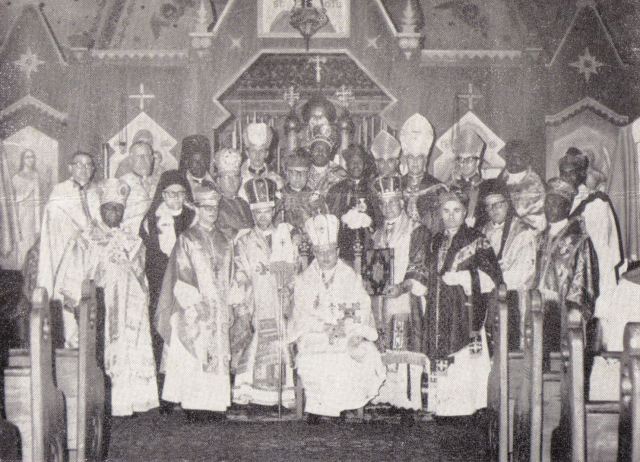
Once he had settled in the United States, Father Ryzy-Ryski sought ecumenical contact with Orthodox jurisdictions that were prepared to help Belarus. He came into contact with Patriarch Wolodymyr (Walter Myron Propheta) (1912-72) of the American Orthodox Catholic Church, and joined that jurisdiction. The AOCC, which was incorporated in 1965, was another attempt to build an indigenous American Orthodoxy inspired by the earlier example of Archbishop Aftimios Ofiesh, being non-ethnically and non-nationally established and welcoming all who sought Orthodoxy. Patriarch Wolodymyr  based his church upon a steadfast witness to the seven Ecumenical Councils but allowed his bishops a free choice of liturgical and other matters provided these were in accordance with an Orthodox understanding. Since the AOCC was in communion with Patriarch Peter, this was the context in which he and Father Ryzy-Ryski first met. On 19 September 1965, Patriarch Wolodymyr and Patriarch Peter with other bishops consecrated Father Ryzy-Ryski to the Sacred Episcopate as Bishop of Laconia, New Hampshire and the New England States for the AOCC.
based his church upon a steadfast witness to the seven Ecumenical Councils but allowed his bishops a free choice of liturgical and other matters provided these were in accordance with an Orthodox understanding. Since the AOCC was in communion with Patriarch Peter, this was the context in which he and Father Ryzy-Ryski first met. On 19 September 1965, Patriarch Wolodymyr and Patriarch Peter with other bishops consecrated Father Ryzy-Ryski to the Sacred Episcopate as Bishop of Laconia, New Hampshire and the New England States for the AOCC.
Patriarch Peter and Bishop Ryzy-Ryski quickly began to consolidate their joint work for Belarus. On Christmas Day 1965, Patriarch Peter elevated to the rank of Archbishop and consecrated Archbishop Ryzy-Ryski, to be the Apostolic Administrator of the Byelorussian Orthodox Catholic Church and the Holy Synod of SUBOZHNIA. Archbishop Ryzy-Ryski also served as Chancellor to the Holy Orthodox Catholic Patriarchate of America. In his role as Apostolic Administrator of the BOCC, Archbishop Ryzy-Ryski then presided over the election of Patriarch Peter to be Patriarch of the Byelorussian Patriarchate of St Andrew the first-called Apostle (БЕЛАРУСКІ ПАТРЫЯРХАТ СЬВЯТОГА АПОСТАЛА АНДРЗЯ). He established the first pro-Cathedral, called “Bielorussicum”, in Shrub Oak, New York.
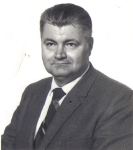
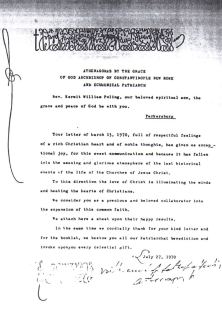
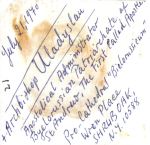
In 1967, without leaving his other jurisdictions, Archbishop Ryzy-Ryski began a new mission, the American World Patriarchates, and was elevated as Patriarch Uladyslau I. This loosely-structured mission sought to create an international hierarchy of bishops and in the following years expanded with the appointment of patriarchs for Puerto Rico, Colombia, Haiti, Santo Domingo, Brazil, Peru, Argentina, El Salvador, Nigeria, the West Indies, Norway, Sweden, Taiwan and the Ukraine. Patriarch Uladyslau spoke additionally of acting to “prevent the spiritual division of the Slavic Peoples dominated by the tyrannical Moscow Patriarchate” through the initiation of an All-Slavonic Patriarchate with his Ukrainian bishop Adam Bilecky (Or’Tata Bozh). This body made contact with the then-imprisoned Josyf Slipyj, patriarch of the Ukrainian Greek Catholic Church.
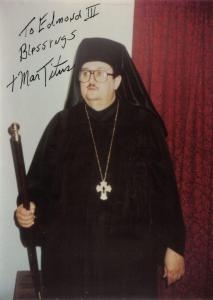
Meanwhile, Patriarch Peter had taken further steps to strengthen the Byelorussian Orthodox Catholic Church. Unsurprisingly, Patriarch Peter would also look to aristocracy as a means of combining sacred and secular authority, holding that a prelate could also be a temporal ruler as indeed many Eastern Orthodox patriarchs had been in former times. When in the late 1960s Patriarch Peter came into contact with the future Prince Kermit of Miensk, then the Revd. Kermit William Poling (1941-2015), he recognized that Prince Kermit’s genealogical descent from the first Belarusian and Polish monarchs, together with his religious vocation, could equip him to undertake an unique role. Prince Kermit had already received the commendation of the Ecumenical Patriarch in a letter of 27 July 1970.
On 1 November 1970, Patriarch Peter consecrated Prince Kermit to the Sacred Episcopate and appointed him to the position of Ecclesiast of All Byelorussia. As a result, while Patriarch Peter remained its spiritual head, the executive functions of the Byelorussian Patriarchate of St Andrew the First-Called Apostle now derived upon Prince Kermit as head of its Holy Synod. At the same time, Patriarch Peter created and enthroned Prince Kermit as Prince of Miensk and Duke of Smolensk. These appointments placed Prince Kermit as the standard-bearer for the Royal Belarusian nation. Patriarch Peter accepted the Order of Ivan the Infante, the House Order of the Royal House Polanie-Patrikios reserved for members of the Royal Family, and became Exalted International Patriarch of the Holy and Blessed Order of the Sacred Cup until his retirement in favour of Prince Kermit in 1988.
Prince Kermit pursued a number of alliances as Ecclesiast of All Byelorussia.

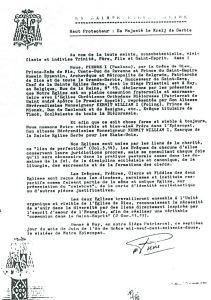
Under his aegis the Patriarchate entered intercommunion with the Holy Church of Serbia under Patriarch Pierre I (Pasleau de Charnay), which was under the patronage of His Imperial Majesty Marcianus II Lavarello, pretender to the Byzantine and Serbian thrones. On 29 January 1972, the Emperor conferred upon Prince Kermit the titular see of Timok in the Holy Church of Serbia.

In 1972, Prince Kermit also negotiated an agreement of intercommunion between the Byelorussian Patriarchate and the Apostolate of the Holy Wisdom of which the Ancient Orthodox Catholic Church was a constituent body under the headship of Maran Mar Basilius Abdullah III (Dr William Bernard Crow) (1895-1976). The Ancient Orthodox Catholic Church was a senior representative of the succession of the Syrian missionary bishop Jules Raimond Ferrette (1828-1904) and had come into existence after the Western extensions of the Syrian Patriarchate had declared the Syrian Orthodox Patriarch to be in schism at the Council of London in 1943. Mar Basilius Abdullah III, himself a great royalist as well as a distinguished scholar in the field of biology (Doctor of Science in the University of London), imparted

conditional consecration to Prince Kermit by ekonomia at his London oratory on 11 April 1972, giving him the Eastern title of Mar Titus, and additionally appointed him to the Sacred Antiochene Order of Saints Peter and Paul.
Prince Kermit devoted the rest of his life to the support of the cause of monarchism. He obtained the recognition of many Orthodox hierarchs and members of other Royal Houses for the new Royal House Polanie-Patrikios and its House Orders, culminating in the 1995 Ceremony of Affirmation in the Hagia Sophia, Constantinople, in which the status of the Royal House Polanie-Patrikios was acknowledged. He was also a committed and long-serving ecumenical Christian pastor, working principally within the ministry of the United Methodist Church in West Virginia at the same time as holding episcopal rank within several Orthodox denominations.
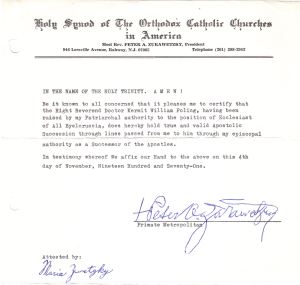
Closely related to the appointment of Prince Kermit of Miensk was the appointment, made by Patriarch Peter with Prince Kermit’s consent, of the Most Reverend Frederick Charles King (1917-85) as Prince of Vilna and All Byelorussia. Prince Frederick was a bishop of the Old Roman Catholic Church who was a good friend of Prince Kermit and who consecrated him by ekonomia on 5 March 1972 in the Bethlehem Chapel of the National Cathedral of Washington. D.C. On his death, Prince Frederick’s honours were inherited by Prince Edmond II of San Luigi, and his successor Prince Edmond III of San Luigi also became Prince of Miensk in 2015, thus uniting the two Belarusian Principalities.


Emergence of related Belarusian churches
When Patriarch Uladyslau died on 1 March 1978 he was succeeded by his brother Emigidiusz (1933-2015), who had been consecrated on February 19 that same year by Patriarch Uladyslau, Patriarch Peter and other bishops, and who now became Patriarch Yuri I of the new Byelorussian Orthodox National Church in Exile (BONC), a member jurisdiction of the American World Patriarchates. On 29 May 1978, Patriarch Peter elevated Patriarch Yuri to be Apostolic Administrator of the American World Patriarchates while still recognizing him to be a Bishop of his own Byelorussian jurisdiction.
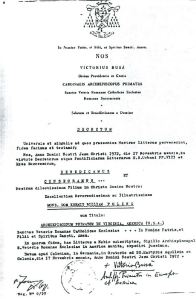
The existing Byelorussian jurisdiction of the American World Patriarchates, the Byelorussian Slavic Orthodox Church Abroad, was led by Patriarch Viktor Ivan Busa (1941-2013), Metropolitan Archbishop of Bialystok, Archbishop of the Old Roman Catholic Church and claimant to the titles of President in exile of the Democratic Republic of Belarus and the Republic of Danzig, and Grand Khan of Tartary and Mongolia. Archbishop Busa consecrated Prince Kermit of Miensk by ekonomia on 17 November 1972 and Prince Frederick of Vilna on 10 August 1972. He recognized Prince Kermit’s authority over Belarus and additionally appointed him as a member of his synod.

Patriarch Viktor devoted his energies to the promotion of world peace through the organization International States Parliament for Safety and Peace (ISPSP) which he co-founded in 1975 together with Archbishop Makarios III, President of Cyprus, and which was chartered by the Presidents of the Republics of Cyprus, Mali and Senegal. The ISPSP was accorded observer status by the United Nations and received diplomatic recognition from a number of countries. Both Prince Kermit of Miensk and Prince Edmond of Miensk formerly served as Deputies of the ISPSP. However, with all activity being co-ordinated from Patriarch Viktor’s home in Sicily, and the ISPSP taking priority, the Byelorussian Slavic Orthodox Church Abroad was somewhat restricted. After the death of Patriarch Viktor, the remaining clergy united with Patriarch Yuri and the American World Patriarchates.
Bishop Karl Pruter, who was consecrated by Patriarch Peter, would write of Patriarch Uladyslau in his work “The Old Catholic Sourcebook” (Garland, New York, 1983, p.70) that he “had one great dream, that one day his native Byelorussia would be liberated and that he would return as its Patriarch. The dream was never realized and it is doubtful that more than a handful of people in his native land ever heard that they had a Patriarch in exile. Yet…it is a certainty that his spiritual sons will ordain priests and bishops in great numbers, and who knows, his patriarchs may become as numerous as Old Catholic and Orthodox bishops.”

In fact, the greatest fulfilment of Patriarch Uladyslau’s work was to be seen in the BONC under the leadership of his brother Patriarch Yuri. After the fall of the Soviet Union, Patriarch Yuri made his first visit to his homeland since childhood in 1993, and thereafter he returned annually. It was clear that there was an appetite among the people of Belarus for the indigenous Orthodoxy offered by the BONC. As of 1993, there was one bishop there, six assisting priests in Minsk, Lida, and Siomki Goradok, and a lay membership of thirty-five thousand which was continuing to grow. By 1997, however, this growth had been halted due to the opposition of the Lukashenko regime, which sent its spies to watch Patriarch Yuri and his clergy and suppressed many of the churches that had opened. In reality, nothing had changed since the days of the USSR, except that it was now being presented with a gloss of “democracy”. Notwithstanding these setbacks, Patriarch Yuri continued to work among diasporan Belarusians in New York until his death in 2015. He also collaborated with other Belarusian clergy and endeavoured to bring about ecumenical links. Following his death, clergy of his jurisdiction united with the Byelorussian Patriarchate of St Andrew the First-Called Apostle under Prince Edmond of Miensk. The clergy of the Patriarchate are therefore also members of the American World Patriarchates by virtue of their association with the late Patriarch Yuri I (Ryzy-Ryski).
Present situation

Prince Edmond of Miensk, who was consecrated bishop in 2006, unites a number of the heritages previously discussed. In 2011, he succeeded as the eighth Prince of San Luigi, a title that was recognized, among others, by the de jure Czar of Russia, Grand Duke Kirill Vladimirovich and King Peter II of Yugoslavia. In 2015, he became Primate of the Apostolic Episcopal Church (The Holy Eastern Catholic and Apostolic Orthodox Church) (AEC). The AEC was recognized by legislative charter of the State of New York in 1932 and is an ecumenical communion with wide links across Orthodoxy and related traditions. It was first recognized by the Ecumenical Patriarchate in 1930 through Archbishop Damaskinos, then acting as the ambassador in the United States of Photios II, Ecumenical Patriarch of Constantinople. The AEC enjoyed full intercommunion with Patriarch Peter II Zhurawetsky, Prince Kermit of Miensk, Patriarch Yuri I, Patriarch Viktor Busa, and the American Orthodox Catholic Church, and thus forms a bridge between all of the churches discussed above. In 2015, Prince Edmond of San Luigi was adopted and designated as successor by Prince Kermit of Miensk, thus becoming Prince of Miensk and Ecclesiast of All Byelorussia of the Byelorussian Patriarchate of St Andrew the First-Called Apostle.
Until April 2023, the Patriarchate maintained active missions and congregational outreach in Brazil, which then also expanded to include missions in Africa and Europe. The Most Reverend Dom Nagui Zayat served as Metropolitan and Exarch until his death in 2021. In 2023, in line with the revised ecclesiastical policy of the Abbey-Principality of San Luigi, the decision was taken that the Patriarchate should no longer pursue an international congregational outreach and should instead revert to its previous purely dynastic role under the Prince-Abbot of San Luigi in his positions as Prince of Miensk and Ecclesiast.
Situation today of the Byelorussian Patriarchate of St Andrew the First-Called Apostle
- The Patriarchate affirms its position as the authentic, indigenous and continuous Orthodox Church of Belarus, with Apostolic Succession from the Ecumenical Patriarchate.
- The Patriarchate holds that the Metropolitanate of Kiev and all Rus is legally a part of the Ecumenical Patriarchate, but this position cannot be actualized until the Ecumenical Patriarch declares the Tomos of 1686 to be null. The words of support of the Ecumenical Patriarch for both Patriarch Peter II and Prince Kermit of Miensk are viewed by the Patriarchate as encouraging the re-emergence of the indigenous church of Belarus, loyal to the Ecumenical Patriarch and wholly separate from the Russian Orthodox Church.
- The Patriarchate looks to His All Holiness the Ecumenical Patriarch as its spiritual father. It considers any “Belarusian” church, whether “autonomous” or otherwise, that does not also so acknowledge the Ecumenical Patriarch to be uncanonical and invalid.
- The Patriarchate is under the Apostolic Administration of H.S.H. the Most Reverend the Prince of Miensk, who serves also as President of Holy Synod.
- The Patriarchate actively supports ecumenism across the Orthodox Churches and with all other Churches that hold true to the Orthodox Faith. It stands willing to affiliate through agreements of intercommunion with other Christian Churches subject to the usual conditions.
- The Patriarchate is of both Eastern and Western Rite jointly and equally, reflecting not only its heritage in Eastern Orthodoxy of the Byzantine Rite but its Catholic heritage through Belarus in dispersion in Poland, Lithuania and elsewhere. The emphasis of the Patriarchate is inclusive without compromising the authentic traditions of the undivided Church. Ecumenical Patriarch Athenagoras gave his blessing to the Western Rite in his remarks to a deputation of the (Western Rite) Catholic Orthodox Church of France on 26 October 1954 when he said, “Well! Behold a great event! It is a marvellous thing for us to learn of the revival of Orthodoxy in the West. But I am not surprised that this movement comes from France, this France which has already given us so many beautiful and sweet things. It is an historic moment for all Christendom, and it would be a great fault on our part if we didn’ t understand that we must work at its realization. We know that there is in the West great thirst again for the true Christian tradition.We know also that the climate of’ the Church of Rome, by its authoritarianism so heavy to bear, cannot make possible a true birth in the heart of tradition. May you be the bridge which shall be projected between the Orthodox Church, repository of the true light,and the Roman Church which we love.”
- The clergy of the Patriarchate were dispensed from the former requirement of celibacy by Patriarch Peter II, following earlier practice within the Living Church, and may marry before or after ordination.
- Ordination in the Patriarchate is restricted to baptised males solely.
Position regarding the Russian Orthodox Church
- The Patriarchate has never intentionally broken communion with the Russian Orthodox Church, indeed it has endeavoured to maintain communion under the most difficult and hostile of circumstances.
- The Patriarchate rejects any claim of the Russian Orthodox Church to jurisdiction over Belarus.
- The Patriarchate holds that there are two tropoi of the Russian Orthodox Church: that of the Russian Orthodox Church in Russia and that of the Russian Orthodox Church outside Russia.
- The Patriarchate cannot recognize any purported representation of the Russian Orthodox Church in Russia that is willing to accommodate itself to a republic, particularly a republic in which former or current members of the Communist Party and KGB hold senior office without recanting their past beliefs and actions. Such a purported representation is invalid ab initio. The Orthodox Church can only uphold Monarchy as the Divinely-instituted system of government and no other.
- The Patriarchate upholds and recognizes the Standing Episcopal Conference of 1950 and the Orthodox Church of America as the only legitimate lineal representatives today of the Russian Orthodox Church outside Russia as that Church was constituted before the subjugation of the Russian Orthodox Church by Communism.
Churches recognized by the Patriarchate
The Patriarchate affirms the faith of Eastern and Western Rite Orthodoxy and so in principle accepts all valid sacraments conferred by churches that share this faith, including its fellow members of the Catholicate of the West. For its part, the Patriarchate shares aspects of its history with a number of other churches, which it recognizes as fully canonical. A partial listing of these jurisdictions is as follows:
- The Ecumenical Patriarchate and the Greek Orthodox Church
- The Orthodox Church of America
- Member churches of the Standing Episcopal Conference of 1950
- The Holy Church of Serbia (pending administration)
- The American World Patriarchates: The Byelorussian Orthodox National Church in Exile (pending administration) and The Byelorussian Slavic Orthodox Church Abroad.
The Patriarchate is in full communion with the Holy Synod of the Patriarchate of (the) Bunyoro-Kitara Kingdom, Uganda. It is also a full member of the Catholicate of the West, the ecumenical union of the churches and religious orders under the Abbey-Principality of San Luigi.

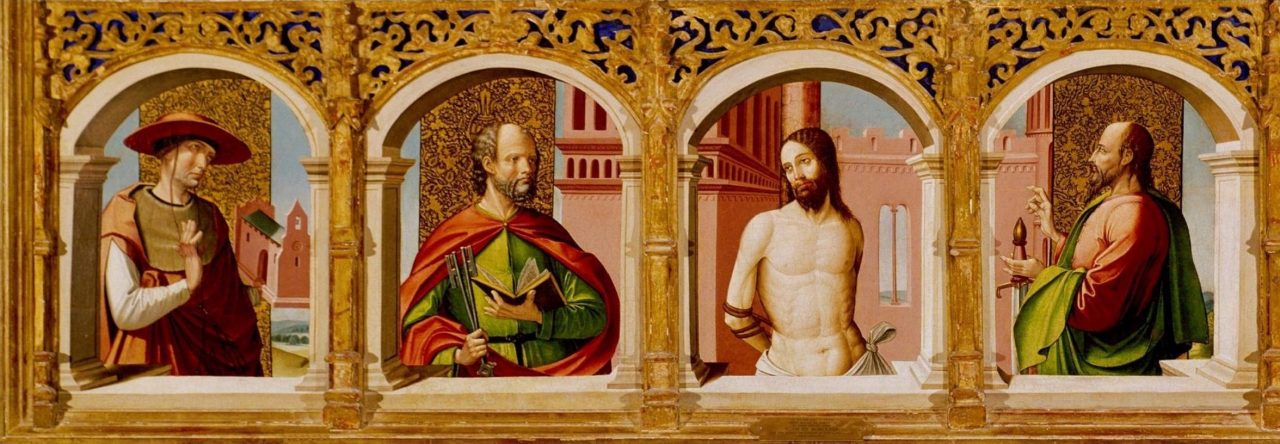


You must be logged in to post a comment.